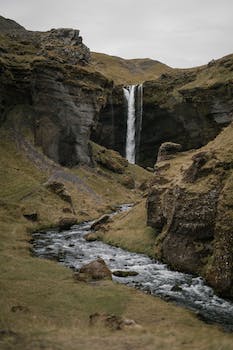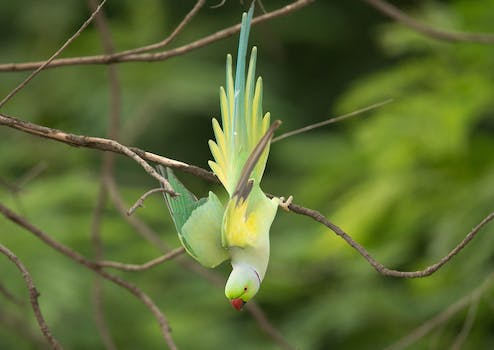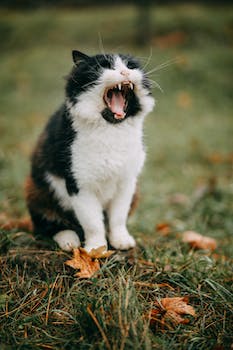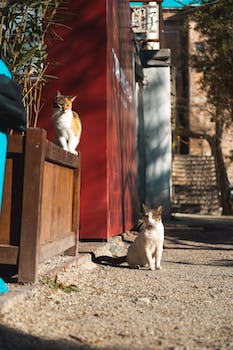

-
Table of Contents
Unveiling the Enchanting World of the Majestic Capercaillie
Introduction
The capercaillie, also known as the wood grouse, is a majestic bird that inhabits the forests of Europe and parts of Asia. With its striking appearance and unique behaviors, the capercaillie has captivated the attention of bird enthusiasts and nature lovers alike. In this article, we will delve into the world of the capercaillie, exploring its physical characteristics, habitat, diet, and breeding habits. Join us as we uncover the wonders of this magnificent bird, the capercaillie.
The Habitat and Behavior of the Majestic Capercaillie
The majestic capercaillie, also known as the wood grouse, is a fascinating bird that can be found in the forests of Europe and parts of Asia. This article will delve into the habitat and behavior of this magnificent creature, shedding light on its unique characteristics and habits.
The capercaillie is primarily found in coniferous forests, where it thrives in the dense undergrowth and tall trees. These forests provide the perfect habitat for the bird, offering both shelter and an abundant food supply. The capercaillie is particularly fond of pine and spruce trees, as their needles and buds make up a significant portion of its diet.
During the breeding season, which typically occurs in the spring, the capercaillie becomes more active and vocal. The males engage in elaborate courtship displays to attract females, often referred to as "lekking." These displays involve the males puffing up their chests, fanning their tail feathers, and making a series of distinctive calls. The purpose of these displays is to establish dominance and attract a mate.
Once a female has been successfully courted, she will lay her eggs in a shallow nest on the forest floor. The female capercaillie is responsible for incubating the eggs, which typically hatch after about three weeks. The chicks are precocial, meaning they are able to leave the nest and feed themselves shortly after hatching. However, they still rely on their mother for protection and guidance.
The capercaillie is a highly territorial bird, with males defending their chosen area from other males during the breeding season. These territories can range in size from a few acres to several square miles, depending on the availability of resources. The males will aggressively defend their territory, often engaging in physical confrontations with intruders.
During the non-breeding season, the capercaillie's behavior changes significantly. The birds become more solitary and spend much of their time foraging for food. They are particularly fond of berries, fruits, and insects, which they find in the forest undergrowth. The capercaillie has a unique feeding technique, known as "browsing," where it uses its beak to strip the needles and bark from trees to access the nutritious inner layers.
In addition to their feeding habits, capercaillies also have a distinctive way of moving through the forest. They have adapted to their environment by developing broad, rounded wings that allow them to maneuver through dense vegetation with ease. This adaptation is particularly useful when the birds need to escape from predators or navigate through thick undergrowth.
Unfortunately, the capercaillie population has been declining in recent years due to habitat loss and hunting. The destruction of their forest habitat and the fragmentation of their territories have made it increasingly difficult for these birds to find suitable breeding grounds. Conservation efforts are underway to protect and restore capercaillie habitats, but more needs to be done to ensure the survival of this majestic species.
In conclusion, the capercaillie is a remarkable bird that thrives in the coniferous forests of Europe and Asia. Its unique habitat and behavior make it a fascinating subject of study for researchers and nature enthusiasts alike. By understanding and appreciating the capercaillie's needs, we can work towards preserving its habitat and ensuring its continued existence in the wild.
Conservation Efforts for the Capercaillie Species

Conservation Efforts for the Capercaillie Species
The capercaillie, also known as the wood grouse, is a majestic bird that inhabits the forests of Europe and Asia. With its striking appearance and unique mating rituals, the capercaillie has captured the attention of bird enthusiasts and conservationists alike. However, due to habitat loss and hunting, the capercaillie population has been declining in recent years. In response to this alarming trend, various conservation efforts have been implemented to protect and restore the capercaillie species.
One of the primary conservation efforts for the capercaillie is the preservation of its habitat. The capercaillie relies on large, mature forests with a diverse range of vegetation for its survival. These forests provide the bird with ample food sources, nesting sites, and protection from predators. To ensure the capercaillie's habitat remains intact, protected areas have been established, and logging restrictions have been put in place. Additionally, reforestation projects have been initiated to restore degraded habitats and create new suitable areas for the capercaillie to thrive.
Another crucial aspect of capercaillie conservation is the reduction of hunting pressure. Historically, the capercaillie has been hunted for its meat and feathers, leading to a significant decline in its population. To address this issue, hunting regulations have been implemented, including limited hunting seasons and bag limits. These regulations aim to strike a balance between sustainable hunting practices and the preservation of the capercaillie population. Furthermore, educational campaigns have been launched to raise awareness about the importance of responsible hunting and the need to protect this iconic species.
In addition to habitat preservation and hunting regulations, captive breeding programs have been established to bolster the capercaillie population. These programs involve breeding capercaillie in captivity and releasing them into the wild to increase their numbers. By carefully selecting individuals for breeding based on genetic diversity and health, these programs aim to enhance the overall genetic pool of the capercaillie population. Moreover, these captive-bred birds can serve as a source population for reintroduction efforts in areas where the capercaillie has become locally extinct.
To monitor the effectiveness of conservation efforts and gather valuable data, researchers have been conducting extensive studies on capercaillie populations. These studies involve tracking individual birds, monitoring their behavior, and assessing the health of their habitats. By collecting this information, scientists can identify potential threats to the capercaillie and develop targeted conservation strategies. Additionally, these studies contribute to our understanding of the capercaillie's ecology and provide valuable insights into its conservation needs.
In conclusion, the capercaillie is a remarkable bird that requires dedicated conservation efforts to ensure its survival. Through habitat preservation, hunting regulations, captive breeding programs, and scientific research, conservationists are working tirelessly to protect and restore the capercaillie population. By raising awareness about the importance of this species and implementing effective conservation measures, we can hope to see the capercaillie thrive once again in its natural habitat. It is our responsibility to safeguard this majestic bird for future generations to appreciate and admire.
The Importance of Protecting the Capercaillie's Natural Environment
The Capercaillie, also known as the wood grouse, is a majestic bird that inhabits the forests of Europe and Asia. With its striking appearance and unique mating rituals, the Capercaillie has captured the attention of bird enthusiasts and nature lovers alike. However, this magnificent bird is facing numerous threats to its survival, primarily due to the destruction of its natural environment.
The Capercaillie relies on dense, mature forests for its survival. These forests provide the bird with the necessary cover and food sources, such as berries, leaves, and insects. Unfortunately, deforestation and habitat fragmentation have significantly reduced the availability of suitable habitats for the Capercaillie. As a result, the bird's population has declined drastically in recent years.
Protecting the Capercaillie's natural environment is of utmost importance for its survival. By preserving and restoring the forests that the bird depends on, we can ensure that future generations will have the opportunity to witness the beauty of this magnificent creature. Additionally, protecting the Capercaillie's habitat benefits other species that rely on the same forests for their survival, creating a ripple effect of conservation efforts.
One of the key strategies for protecting the Capercaillie's natural environment is implementing sustainable forestry practices. This involves carefully managing the harvesting of timber to minimize the impact on the bird's habitat. By selectively cutting trees and leaving behind patches of mature forest, we can create a mosaic of habitats that cater to the diverse needs of the Capercaillie and other forest-dwelling species.
Another crucial aspect of protecting the Capercaillie's natural environment is establishing protected areas. These designated areas serve as sanctuaries for the bird, where human activities are limited or prohibited. By designating specific regions as protected areas, we can ensure that the Capercaillie has access to undisturbed habitats where it can thrive and reproduce.
In addition to sustainable forestry practices and protected areas, raising awareness about the importance of the Capercaillie's natural environment is essential. Educating the public about the bird's habitat requirements and the threats it faces can inspire individuals to take action and support conservation efforts. This can be done through educational campaigns, nature walks, and community involvement in habitat restoration projects.
Furthermore, collaboration between governments, conservation organizations, and local communities is crucial for the successful protection of the Capercaillie's natural environment. By working together, we can develop and implement effective conservation strategies that address the various challenges faced by the bird. This includes addressing issues such as illegal logging, poaching, and the encroachment of human settlements into the bird's habitat.
In conclusion, protecting the Capercaillie's natural environment is vital for its survival. By implementing sustainable forestry practices, establishing protected areas, raising awareness, and fostering collaboration, we can ensure that this majestic bird continues to grace our forests for generations to come. The Capercaillie's conservation is not only important for the bird itself but also for the overall health and biodiversity of our forests. Let us join hands in preserving the natural habitats that are home to this magnificent creature.
Q&A
1. What is the Capercaillie?
The Capercaillie is a large bird species belonging to the grouse family.
2. Where can the Capercaillie be found?
Capercaillies are native to the forests of Europe and parts of Asia.
3. Why is the Capercaillie considered majestic?
The Capercaillie is known for its impressive size, striking appearance, and elaborate courtship displays, which contribute to its majestic reputation.
Conclusion
In conclusion, discovering the majestic capercaillie is a fascinating experience that allows individuals to appreciate the beauty and uniqueness of this bird species. Through research and observation, scientists and nature enthusiasts have gained valuable insights into the behavior, habitat, and conservation of the capercaillie. The capercaillie's impressive size, distinctive appearance, and elaborate courtship displays make it a captivating subject for study and admiration. Protecting the capercaillie's habitat and implementing conservation efforts are crucial to ensuring the survival of this magnificent bird for future generations to appreciate.












